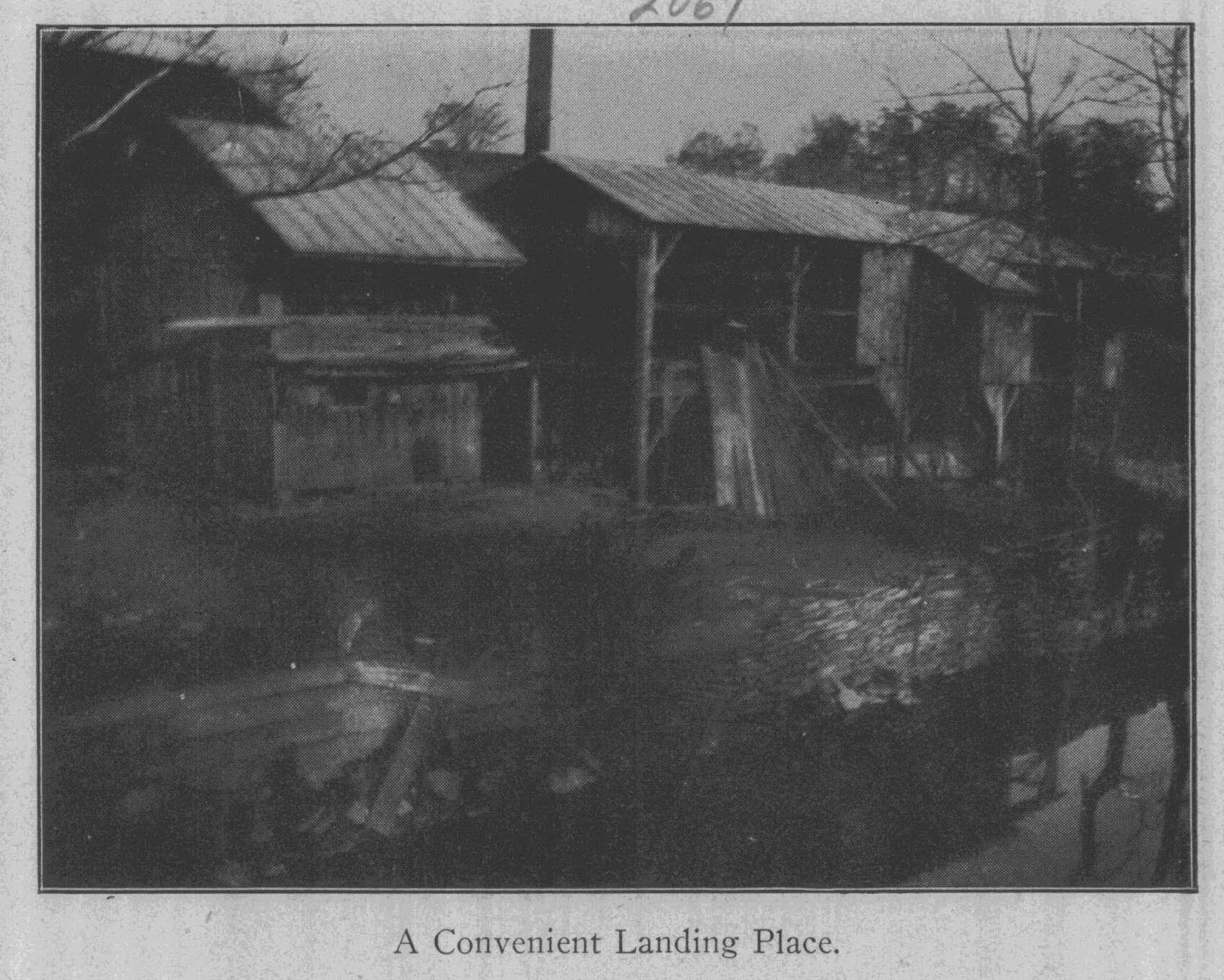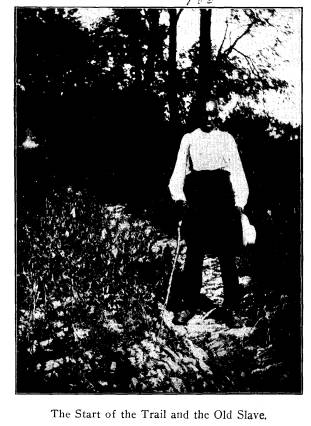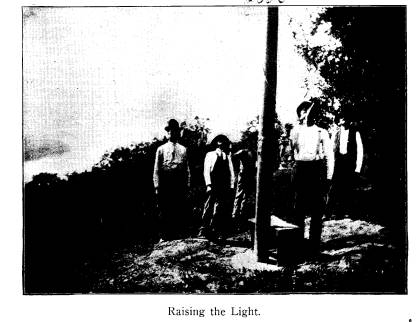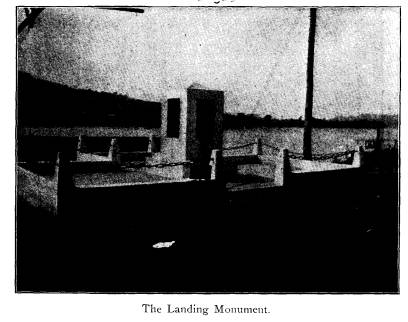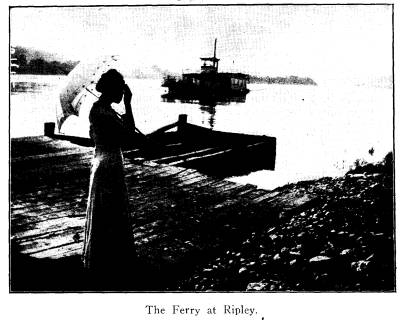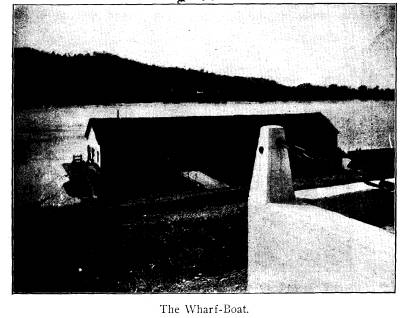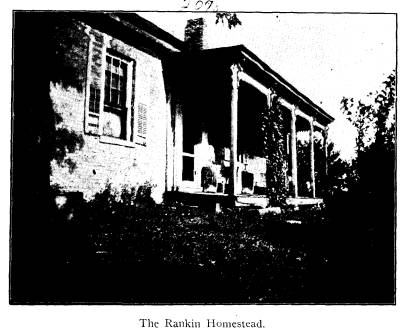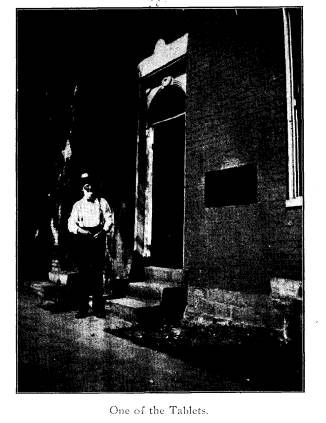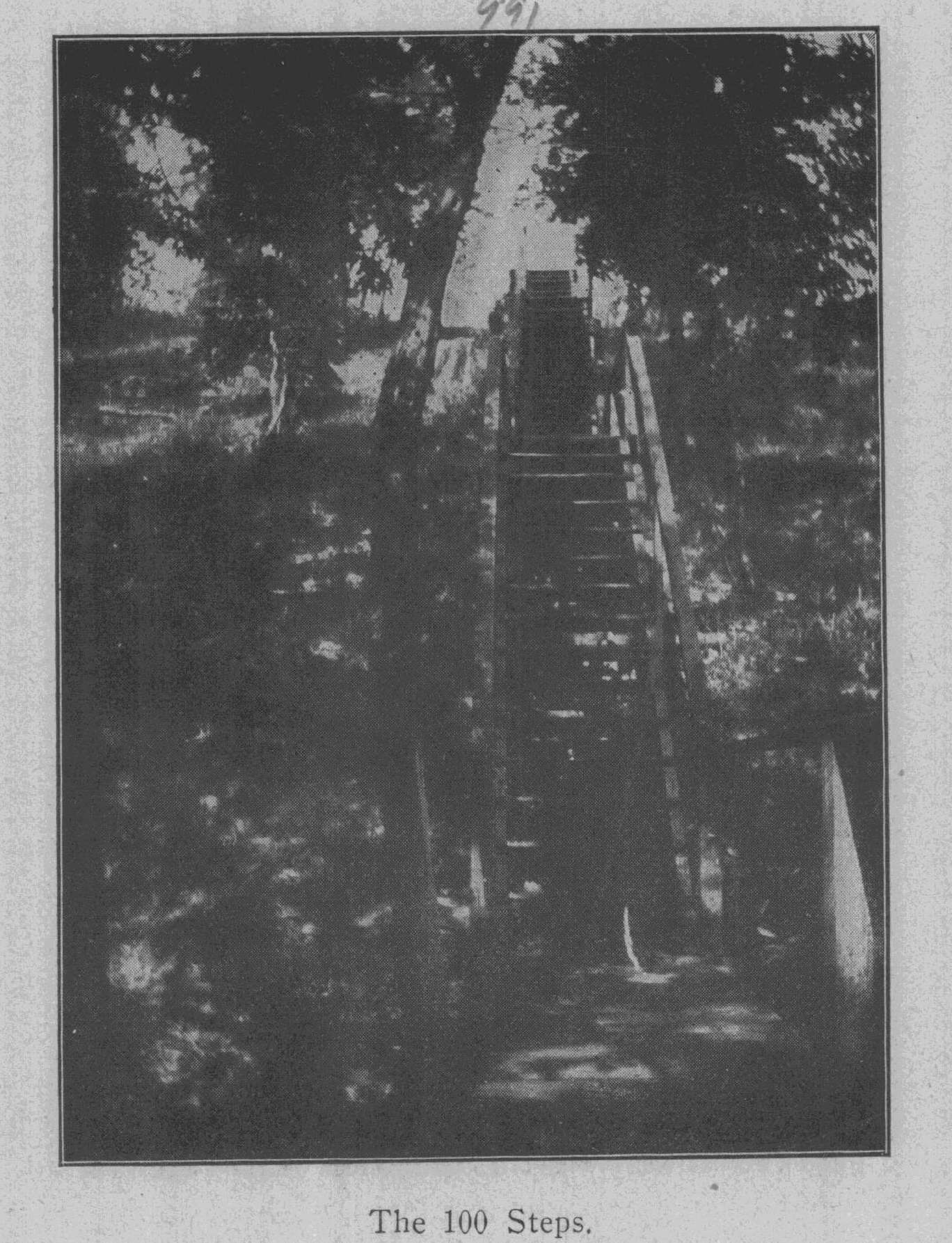Ohio History Journal
MARKING THE OLD "ABOLITION HOLES."
BY FELIX J. KOCH, CINCINNATI.
A quadroon girl, in Sunday best,
strolled down the quiet
little main street of Ripley, in
southern Ohio, not long since, and
coming to the crest of the bluff, whence
the long descent begins
to the river, she rested her arms on an
immaculately white monu-
ment, set to the famous old
abolitionists of Ripley,-the place
where Eliza crossed the ice, in the
story-and waved a hand-
kerchief, in signal to some dusky
paramour on the other side.
Behind the girl there lay, as
back-ground to the picture, the
quiet by-ways of Ripley; behind these,
in turn, rose a ridge of
hills, the banks these of the
prehistoric Ohio.
Crowning this crest and visible by day
from afar for a flag
and staff recently set there, and by
night for a lantern hoisted
on that same flagpole, from the portico
of an old homestead other
folk were waving to kin, likewise in
Kentucky, and that these,
too, understood and heeded was made
evident by the ferry cross-
ing, shortly after, and bringing them to
this side.
So simple, so easy, today, this crossing
of the Ohio on the
filthy ferryboat there at Ripley; but
what a trip it was to the
ancestors of the same quadroon girl, to
whom the Ohio shore
spelled liberty, and freedom! With what
eager eye, too, by way
of contrast did old man Rankin and his
stalwart sons, watch,
from that home there on the heights, the
negroes working their
way, by aid of some staunch log more
frequently than not, 'cross
the river and to the shore; there to be
helped by one friendly
to their cause and come up here, to be
sped on to Sandusky and
the North. Just recently a son of
Ripley, who went out in his
early youth and who is now established
at Cleveland, having
returned for its centennial home-coming
week, commemorated his
visit by erecting a series of tablets,
here, there and elsewhere
about the town, and a flagpole there on
the heights, upon which
(308)
|
Marking the Old "Abolition Holes." 309 every night a lantern is now lighted, much as it was to guide the fugitive slaves a half-century before. What a climb, too, they must have had of it, for even now it is all that a man can do, of a warm summer's day, to take the trail, and this without fear of bloodhounds at his heels. Homes, gardens, fences prevent one getting there directly. From the main street paralleling the river you turn up one square, cross the railway tracks, and pass along backyards of |
|
|
|
residences to the second street parallel. Here cheaper homes, in yards set above the street and screened by trees, succeed; and while the streets are oiled today, tradition has it that once their mud made slow the crossing. From here the flagpole is plainly seen on the heights while from this second thoroughfare already that hill slopes up, to terminate eventually at the Rankin home- stead. Scattered little homes of colored folk, descendants, for the most part, of fugitive slaves, are 'round about here. Pic- caninnies flock out to watch the train returning to Cincinnati,- |
|
310 Ohio Arch. and Hist. Society Publications. it is 2:10 in the afternoon now,-and you, who would continue the climb realize that there is no returning for you save by that miserable ferry into Kentucky and then the railway ride on that side, later on. Disheartened, you continue to the attack of the hillside. In |
|
|
|
a little garden hundreds of watermelons and nutmegs are ripen- ing, and tempt you to purchase and taste. Squares of olden time, cheap frames trend away here, hardly a one but hid its slaves in its time. At a cross street the old trail to the top has its start here,-huge, foot-wracking boulders, being set in the weeds be- |
|
Marking the Old "Abolition Holes." 311 neath thorny acacia tree. An old negro of the village loiters in the shadows,-Henry Hoster his name, "an' it please you sir". -He and two or three others fled to the Union army when they were recruiting at Maysville, during the War, and thus he ob- tained his freedom. A picturesque darky town is encountered at this point. Out before the negro shanties, piccaninnies crow in their cradles. A quaint old church of brick too rises from the trees. Grass grown, |
|
|
|
what was once a highway leads across, flanking small gardens, edged with corn. But, you're already feeling the results of the climb plus the heat and the elevation. Your heart is beating wild and as you come to the fourth cross-street you stop,-for excuse that you'd look back at the river and the church towers you're about level with. Sweltering as it is, there were just such days when slaves dashed hot-footed up this same hill. Your way, though, is blocked by the topography of the hill- |
|
312 Ohio Arch. and Hist. Society Publications. side. You'll have to turn down about half a block, through a path at the side of the hill and winding through fields fairly torrid. Only semi-occasionally a negro hut is edging this way,- the white house at its end seems to grow always more distant. Reaching this goal the Hundred Steps then reward you. Again through sun-baked meadows, and corn-fields and, finally, forest they ascend, straight as can be,-and it seems, from below, |
|
|
|
as if they make their way onward and upward to the flagpole and the door of the Rankin homestead itself. But, hillsides along the Ohio are always deceptive, and so is the seeming unbrokenness of the stairs. There are places where the path-finding is actually FIERCE, - as you pick your way from one to the next of the rocks! How fugitive slaves could ever get up it, especially with men armed with guns at their heels,-you fail to comprehend, the more that you all but faint on your climb,-and YOU take it in easy stages. From one tree to the next you scurry, to leave sunshine for |
|
Marking the Old "Abolition Holes." 313 shade, and, instinctively you wonder if these "100 Steps" should not really be called the "500". All things must end, and so with this trail. It comes to its end at a flight of new wooden stairs ascending in three laps to the top. Where they start,-again dallying,-you've a splendid view up the river to where there's a bend, almost hidden by flat Ohio farmland, and down to another fine bend in the hills. Just |
|
|
|
below, Ripley bakes despite its shelter of trees, and the two church towers seem to melt in the sunshine. On, on, on, to the top you keep going! That climb is ter- rific:-you fear again you will faint. Finally at Excelsior, you fling yourself down, 'neath a tree and survey the prospect, the far-famed Rankin homestead. It resolves itself into an old prosaic one-story brick, with roof slop- ing to rear, and the front facade broken alternately by window, door, window :-door, window. A crumbling old portico is at mid-front, and here the morning glories climb up one pillar. |
|
314 Ohio Arch. and Hist. Society Publications. A flock of brown chickens rests in a flower bed,-you re- mark too be-flowered shades in the windows of the many small panes. Trees are few up here, the place is set right out in the sun, and, at rear, fields of corn and tobacco promise no better. Off at one side there's an orchard, the other surveys a rolling meadow. By this time you've regained your equanimity somewhat; your heart is no longer pumping so wild,-the perspiration comes |
|
|
|
a little less freely. You're ready to enjoy this glorious view at the front,-though you doubt if even it repays such a climb. A handy bench and a bit of restorative fit you to stop and jot down the impressions, and take pictures. Meanwhile the present tenant relates how, at the Centennial, they put this flagpole here and had services down in the town. Yes, he would get in the picture,-he raised the lantern here every night. And, wouldn't we drink from his well before start- ing the long downhill trip back to town ? It was the same well |
|
Marking the Old "Abolition Holes." 315 from which the fugitive negroes refreshed themselves on ar- rival. Then, as we sat there, they recounted incidents of old slave days down in Ripley. Every house of any moment in connec- tion with speeding on run-away negroes has its tablet now, thanks to this Clevelander's gift. We could ferret these out, in a stroll on the main street, when we got back down below. |
|
|
|
But, meanwhile they spun the story of the old dwelling as it was told by Captain R. C. Rankin, one of the abolitionist's seven sons, some years ago. "My father's prime service to the fugitives," he said, "was to furnish food and shelter." "His sons, of whom there were nine, did the conveying away. Some attempts were made to search our house from time to time. In March, 1840, for example, four men from Kentucky and one from Ripley with two bulldogs, came to the house and were met on the porch by mother, of whom they inquired the |
|
316 Ohio Arch. and Hist. Society Publications. way to Mr. Smith's,-a neighbor of ours. On being directed, the spokesman, Amos Shrope, said: "'Madam, to be plain with you, we do not want to go to Mr. Smith's, but there was a store broken open in Dover, Ky., and we have traced the thief to this house:-we want to search for the goods and the thief.' |
|
|
|
"Mother replied: 'We neither harbor thieves nor conceal stolen property, and you are welcome to come to look through the house.' "On starting for the door, my brother, Rev. S. G. Rankin, now of Glastonbury, Conn.. took down the rifle from over the |
|
Marking the Old "Abolition Holes." 317 door, cocked it and called out: 'Halt! If you come one step farther I will kill you,' and they halted. My brother David and I had not yet returned home from conveying the fugitives to the next station North, but were soon on the scene, when word was sent to town and in a short time the yard was full of friends. |
|
|
|
The slave-hunters,-for such they were,-were not allowed to pass out at the gate, but were taken by each arm and led to the fence and ordered to climb,-and they climbed! "In the early days of abolitionism, my father was lecturing to an audience in a grove at Winchester, 0., when a mob of two |
318
Ohio Arch. and Hist. Society Publications.
hundred men, armed with clubs, marched
to the place; and their
leader, Stivers by name, came down the
aisle and up on the stand,
drew his club over father and called
out:
"'Stop speaking, or, damn you, I
will burst your head!
"Father went on as though nothing
had happened, when
Robert Fatten, a large and powerful man,
sprung forward and
seized Stivers by the back of the neck
and led him out,-and
that ended it.
"On another occasion father was hit
with a goose-egg, it
struck the collar of his coat and did
not break until it fell,-when
out came a gosling.
"He frequently came home with his
horse's mane and tail
shaved, when he would calmly remark: 'It
was a colonization
reply to an abolition lecture.'
"On one occasion I was sent to the
house of a lone widow,
being told that there were three men in
her house, hunting run-
aways. I buckled my revolver under my
vest and proceeded
thither. I knew one of the men, a
desperate character, who had
killed one man at Hamilton, 0., and had
waylaid and shot an-
other near his home in Kentucky. I
approached him first and
asked him to leave the house; after
waiting a few moments and
seeing he was not disposed to move, I
put my hand on his breast
to gently urge him out, when he ran his
right hand in his pocket
and grabbed his revolver; but I was too
quick for him and had
mine cocked within three inches of his
eyes and shouted:
"'Now if you draw your hand out I
will kill you'!
"He believed it and so stood, when
one of his companions
stepped up and slipped into his left
hand an Allen self-cocking,
six-shooting revolver. I exclaimed:
'That will do you no good,
for if you raise your arm I'll put a
bullet through your brain.'
He also believed that. In this position
we were found by a
colored citizen of Ripley who came in
with a double barrelled
shotgun. In a short time a crowd
gathered and the hunters were
taken before the mayor and fined $60 and
costs."
Old Rankin left eight sons and two
daughters to survive
him and perpetuate the memory of the
famous old "abolition
hole" there on the hill.
